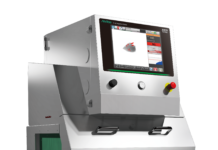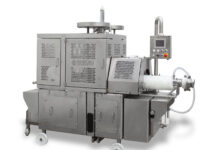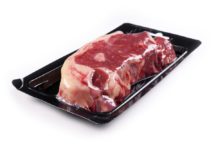Meat MAP applications are usually based on preformed or thermoformed base trays made from plastic polymers multilayers as such as PVC(unplasticized)/PE, PET/EVOH/PE or PS/EVA/PE; lidding films can be of PVDC/PP/PE, PET/PE, PA/PE; flow wrap films can be of PA/PE, PA/EVA/PE (7). MAP equipments may use a vacuum pump to remove atmospheric air prior to MAP gas mixture insufflations, or directly flush that air away with the gaseous mixture of choice, before heat sealing the film layers. Innovations in plastic materials and equipments have contributed to a continuous improvement in MAP applications and results. Some recent applications (both low O2 and high O2) are:
 – Form-fill-seal MAP: the barrier tray is often produced off-site, but it may be cost-effective (especially for big packaging plants) to install a form-fill-seal packaging equipment, where the web or base film is heated and drawn into the tray mold by vacuum; meat can be placed into the formed tray cavity before heat sealing of barrier film to the top edges of the formed tray.
– Form-fill-seal MAP: the barrier tray is often produced off-site, but it may be cost-effective (especially for big packaging plants) to install a form-fill-seal packaging equipment, where the web or base film is heated and drawn into the tray mold by vacuum; meat can be placed into the formed tray cavity before heat sealing of barrier film to the top edges of the formed tray.
– VSP (vacuum skin packaging) with peelable lid: the meat cut is put in the tray then the sealing barrier film is heat shrunk to conform to product shape; the film has an outer peelable barrier layer and an inner air-permeable layer so that before retail display the outer barrier layer is peeled away: air can contact the meat and cause a bloomed red colour instead of purple color (unfamiliar to many customers) typical of deoxymyoglobin state. Because air-permeable films may not allow sufficient O2 passage for adequate MbO2 formation, microperforated shrink films have been manufactured to promote faster colour blooming.
– Air-permeable overwrapped trays in master packs: non-barrier overwrapped trays of meat are enclosed in a large barrier film master pack that contains multiple packages in anoxic gas. When the master pack is removed for retail display, the meat pigments become oxygenated.
– Tray-in-sleeve MAP: using the same approach than previous system, but the overwrapping pouch is sized for each individual tray package. When overwrapping sleeve film is removed from individual trays for retail display, the meat pigments become oxygenated.
– Active/smart MAP: packaging becomes active when it performs a series of responses to maintain quality and safety of food; smart or intelligent packaging interacts with the product to provide information of its conditions (8). Both can be combined to MAP, e.g. using O2, CO2 or moisture scavengers/absorbers; antioxidant or natural preservatives releasing systems; self-cooling materials; O2, CO2 or temperature variations sensors; indicators for specific compounds; etc.
Bibliografia
1)Soroka W., Fundamentals of Packaging Technology. Institute of Packaging Professionals, 2009 (4th edition)
2)Hoyle Parks A.R. et al., Shelf life and stability traits of traditionally and modified atmosphere packaged ground beef patties treated with lactic acid bacteria, rosemary oleoresins, or both prior to retail display. Meat Science, 90 (2012) 20-27
3)Alonso V. et al., The impact of short-term feeding of magnesium supplements on the quality of pork packaged in modified atmosphere. Meat Science, 90 (2012) 52-59
4)Piergiovanni L. and Limbo S., Food Packaging – materiali, tecnologie e qualità degli alimenti. Springer editore, 2010
5)Zakrys-Waliwander P.I. et al., The effects of high oxygen modified atmosphere packaging on protein oxidation of bovine M. longissimus dorsi muscle during chilled storage. Food Chemistry, 131 (2012) 527-532
6)www.cmc-cvc.com/english/documents/ModifiedAtmospherePackagingFactSheet.pdf
7)McMillin K.W., Where is MAP going? A review and future potential of modified atmosphere packaging for meat. Meat Science, 80 (2008) 43-65
8)Ibid.



